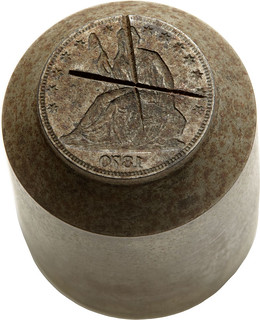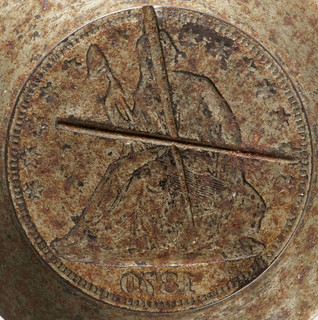
PREV ARTICLE
NEXT ARTICLE
FULL ISSUE
PREV FULL ISSUE
VOCABULARY TERMS: DEFACED AND CANCELED DIESDick Johnson submitted these entries from his Encyclopedia of Coin and Medal Terminology. Thanks! -Editor
  Canceled 1870 Half Dollar Obverse Die Cancel. To withdraw from further use. To cancel a die is to mutilate it in such a way that a pristine specimen cannot be struck from it; to cancel a coin or medal is to physically change it from it’s original state. Dies are cancelled when a limited edition has reached its announced quantity struck, or when no further use can be made from that die. Coins and medals are cancelled when it is not convenient to toss them in a melting pot. They are cut, holed, mashed, segmented or corrugated. The pieces are then stored until they can be placed in a melting pot as a first step of recovering their metal content. In 2001 with the introduction of the new Euro coinage in selected countries in Europe, when old coins were replaced by the new coinage they were
cancelled by perforation. A machine used in France pierced 12 tiny holes in each coin. The machine was called a trouilloteuse. See DEFACE,
MELTING. Canceled Die. After a coin or medal issue is completed, and to guarantee no unauthorized specimens can be struck,
dies are sometimes canceled by defacing (or destruction). Coin dies are severely treated when canceled: the face containing the design can be
entirely ground off, melted by intense flame or otherwise obliterated. Medal dies are usually DEFACED with a thin line or lines ground into the face
of the die through the design. Any medal struck from such dies would show these defacing marks and are called STRUCK FROM CANCELED DIES (as evidence
they have, indeed, been canceled). Sometimes canceled dies are then preserved in archives of a museum. The medal illustrated shows not only a line
ground into the face of a die but also a line of lettering sunk into this channel as well. Deface. Purposefully mutilating the face of a die to prevent its further use; to CANCEL. Dies can be defaced by grinding lines across their surface so a pristine specimen cannot be struck from it. When a defaced die is so used to strike a specimen the piece is said to be struck from CANCELLED DIES. Other methods of defacing are grinding away the entire striking surface, by torch melting, or by a sledge hammer blow to obliterate all or part of the design. A defaced coin or medal is called VANDALIZED. To read the earlier E-Sylum article, see: Looking for the meaning of a numismatic word, or the description of a term? Try the Newman Numismatic Portal's Numismatic Dictionary at: https://nnp.wustl.edu/library/dictionary Or if you would like a printed copy of the complete Encyclopedia, it is available. There are 1,854 terms, on 678 pages, in The Encyclopedia of Coin and Medal Technology. Even running two a week would require more than 19 years to publish them all. If you would like an advance draft of this vital reference work it may be obtained from the author for your check of $50 sent postpaid. Dick Johnson, 139 Thompson Drive, Torrington, CT 06790. Wayne Homren, Editor The Numismatic Bibliomania Society is a non-profit organization promoting numismatic literature. See our web site at coinbooks.org. To submit items for publication in The E-Sylum, write to the Editor at this address: whomren@gmail.com To subscribe go to: https://my.binhost.com/lists/listinfo/esylum All Rights Reserved. NBS Home Page Contact the NBS webmaster 
|